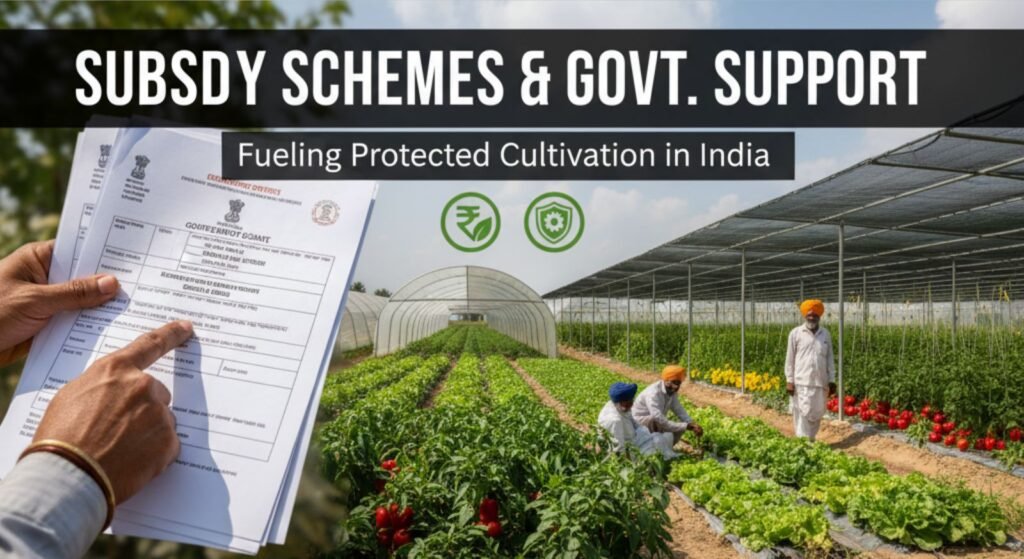Introduction
Farming today is no longer just about sowing seeds and waiting for the rains. With unpredictable weather, rising input costs, and market competition, farmers are looking for smarter ways to secure their crops and improve income. Protected cultivation—through polyhouses, shade net houses, and greenhouses—has become one of the most reliable solutions.
But the question that stops many farmers is: How can I afford it?
The good news is that both the Central Government and State Governments in India provide substantial financial support through subsidies and schemes to encourage farmers to adopt protected cultivation. These subsidies make modern farming technologies more accessible and reduce the burden of high initial investments.
This blog explains the major subsidy schemes available, how they work, and why farmers should consider them as a pathway to profitable and sustainable farming.
Why Protected Cultivation Needs Government Support
Polyhouses, shade nets, and other protected farming structures are capital-intensive. For example:
- A naturally ventilated polyhouse can cost ₹900–1,200 per square meter.
- A shade net house may cost between ₹250–600 per square meter.
For small and marginal farmers, these costs can feel overwhelming. Without support, many would never be able to adopt such technology.
This is where government subsidies play a vital role:
- They reduce upfront investment.
- Encourage more farmers to adopt protected cultivation.
- Support India’s long-term goals of doubling farmer incomes and improving food security.
Key Subsidy Programs for Protected Cultivation
1. National Horticulture Mission (NHM) / Mission for Integrated Development of Horticulture (MIDH)
- Coverage: Pan-India.
- Support Provided: Subsidies of 40% to 50% of the cost for general farmers. For small, marginal, women, and SC/ST farmers, subsidies can go up to 55–60%.
- Structures Covered: Polyhouses, shade net houses, plastic tunnels, and mulching.
- Size Limitations: Subsidies are usually capped to certain square meter areas (e.g., up to 4000 sq. m. per beneficiary).
This is the most popular and widely accessed scheme for greenhouse and shade net installation.
2. Rashtriya Krishi Vikas Yojana (RKVY)
- Aims to promote innovative farming practices including protected cultivation.
- Funds are distributed through state governments, so the level of support may vary from state to state.
- Farmers can avail financial assistance for structures like greenhouses, shade nets, and drip irrigation systems.
3. State Horticulture Missions
Many states such as Maharashtra, Rajasthan, Gujarat, and Karnataka run their own subsidy programs in addition to central schemes. For example:
- Rajasthan provides subsidies up to 60% for shade nets and polyhouses in arid zones.
- Maharashtra encourages floriculture under polyhouses with strong financial assistance.
- Karnataka supports farmers in setting up both naturally ventilated and climate-controlled polyhouses.
4. National Bank for Agriculture and Rural Development (NABARD)
- NABARD doesn’t give direct subsidies but provides credit-linked support.
- Farmers can take loans to set up greenhouses or shade nets, and link them with central/state subsidies for repayment support.
Farmer Benefits Beyond Subsidy
It’s not just about financial aid. These programs come with added benefits:
- Technical Training: Many schemes include farmer training programs to ensure proper use of structures.
- Improved Market Access: Farmers under government schemes often get connected to buyers or cooperatives.
- Insurance Support: Some states also bundle crop insurance with protected cultivation projects.
Challenges in Availing Subsidies
While the schemes are excellent, farmers often face difficulties such as:
- Complex Paperwork – The application process can feel overwhelming.
- Delays in Disbursement – Subsidy release sometimes takes months.
- Awareness Gaps – Many farmers are not aware of the schemes available in their region.
This is where companies like AgroDome Projects LLP play an important role. By guiding farmers through design, installation, and subsidy application, they help reduce stress and make the process smoother.
Case in Point
In Gujarat, a small farmer who installed a 1000 sq. m. shade net house for vegetables saw his investment reduce by nearly half because of a 50% subsidy under NHM. Within two years, he recovered his share of the investment through higher yields of capsicum and coriander. Without subsidy, this project might never have taken off.
Conclusion
Government support is making modern farming possible for thousands of farmers across India. Subsidies for polyhouses, shade net houses, and other protected cultivation methods are not just financial relief—they are an investment in India’s agricultural future.
Farmers who take advantage of these schemes can not only secure their livelihoods but also grow crops that fetch higher prices in the market, even during off-seasons.
If you are considering protected cultivation, now is the time to explore subsidy opportunities available in your state and partner with experts who can guide you through the process.
FAQs
Depending on the scheme and farmer category, you can get between 40% and 60% subsidy on polyhouse construction. SC/ST, women, and small farmers often receive the higher end of support.
No, subsidies usually cover only the initial construction and installation. Farmers need to manage maintenance and repairs themselves.
Generally, farmers can avail one subsidy source per project. However, they may combine central schemes like NHM with credit support from NABARD or banks for easier financing.

